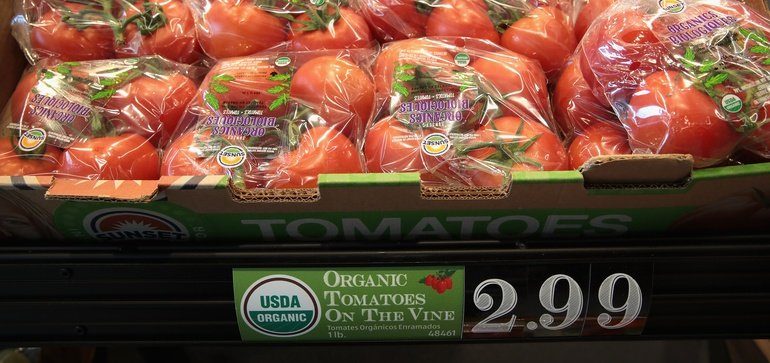Organic food sales hit record $56.4B in 2020

Dive Brief:
- Sales of organic food leaped 12.8% to hit a record $56.4 billion in 2020, according to the Organic Trade Association. This compares to a 4.6% growth rate in 2019. Total sales of organic fruit and vegetables reached $20.4 billion in 2020, pushed by a more than 28% jump in frozen. Sales of organic meat, poultry and fish rose nearly 25% to reach $1.7 billion.
- Among pantry goods, sales of organic flours and baked goods increased 30% as consumers embraced home cooking. Condiment sales rose 31% on strong demand for sauces and spices. The latter saw a 51% growth rate, more than tripling its pace from 2019.
- In 2020, nearly 6% of the food sold in the United States was certified organic, according to the trade group. Even as more consumers visit restaurants in the months ahead, the OTA expects habits such as home cooking and health consciousness to hold as tailwinds for organic.
Dive Insight:
For organic foods, the past year provided nearly the ideal environment for growth.
“The only thing that constrained growth in the organic food sector was supply,” Angela Jagiello, director of education and insights for the OTA, said in a written statement. She noted this held true across all organic categories. Jagiello oversaw the survey, which was conducted on behalf of OTA by Nutrition Business Journal between January and March. She said supply was stretched in terms of ingredients, packaging and labor.
The signs that the pandemic would supercharge organic food growth were there early on. In spring 2020, the OTA reported a more than 20% jump in sales for organic produce. While frozen remains the dominant force for organic fruit and vegetables, fresh still posted a nearly 11% sales increase to reach $18.2 million in full-year 2020. Today, organic owns more than 15% share of total produce sales in the United States, according to the OTA, or $20.4 billion for everything from fresh to frozen to dried.
The OTA numbers echo the growth trend seen in data from the Organic Produce Network and Category Partners, which measured a 14.2% jump in organic produce sales in 2020, compared to a 10.7% increase for conventional produce.
While the OTA does not expect organic foods’ double-digit growth rate to continue in 2021, it said the pace should remain strong. The group is confident that consumers will continue to cook more at home post-pandemic than they did before. A January survey conducted by market research firm Hunter found 71% of consumers expect to cook more at home after the pandemic ends.
The piqued interest in healthy eating overall during COVID-19 also buoyed this trend. One in three consumers said they ate healthier in 2020, according to a survey by the International Food Information Council. Organic food tends to have a health halo among consumers, despite a lack of data backing up that perception.
“What’s come out of COVID is a renewed awareness of the importance of maintaining our health, and the important role of nutritious food. For more and more consumers, that means organic,” Laura Batcha, CEO and executive director of OTA, said in a written statement.
Consumers are also dealing with higher food prices coming out of the pandemic. Increases have been rippling across the broader food and beverage landscape from higher freight, transportation and manufacturing costs and other pandemic-related expenses. Some question consumers’ willingness to pay the higher price tags.
Even last year, when produce sales spiked early in the pandemic, the OTA cautioned consumers may grow unwilling to pay the premium that comes with the certified organic label. A 2017 survey by Mintel found only about one-fifth of consumers agreed organic food was worth the extra cost.
Just as 2020 presented nearly ideal growth conditions for organic food, this year may truly test the sales case for the segment, as more consumers venture out of the house to eat — and encounter higher food prices at the grocery store.
Source: fooddive.com

